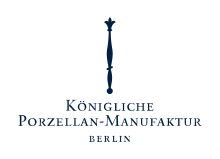 | |
| Company type | Private (GmbH) |
|---|---|
| Industry | Ceramic products |
| Founded | 1763 |
| Founder | Frederick the Great |
| Headquarters | , Germany |
| Products | European hard-paste porcelain |
| Owner | Prince Franz Wilhelm of Prussia |
Number of employees | 150 (in 2013)[1] |
| Website | kpm-berlin.com |

The Royal Porcelain Factory in Berlin (German: Königliche Porzellan-Manufaktur, abbreviated as KPM), also known as the Royal Porcelain Manufactory Berlin and whose products are generally called Berlin porcelain, was founded in 1763 by King Frederick II of Prussia (known as Frederick the Great). Its actual origins, however, lie in three private enterprises which, under crown patronage, were trying to establish the production of "white gold" (i.e. porcelain) in Berlin from the mid-18th century onwards.
The company logo is a cobalt blue sceptre, which is stamped (painted prior to 1837) on every piece. All painted pieces produced by KPM are signed by the painter.
KPM has produced a number of dishware forms and porcelain figurines throughout its history. Some forms have hardly changed their shape in over 200 years of production. Frederick the Great, who, as the owner, jokingly referred to himself as his own "best customer", was under the spell of the Rococo style during his life; a culmination of this artistic style can be seen in his castles.
To this day, the most successful designs of the 1930s are the Urbino, Urania and Arkadia (originally a tea set designed in honor of KPM's 175th anniversary) created by Trude Petri. The Arkadia medallions were created by Siegmund Schütz and the Urania set (with the same basic form as the Arkadia) did not enter production until after the war, as was also the case with the Arkadia table set. Porcelain figurines of different styles corresponding to each era have always been created under the guidance of the master workshop, including the modern animal sculptures, such as the miniature Buddy Bear or the Knut Bear.
- ^ Mitarbeiter Archived 2013-10-20 at the Wayback Machine